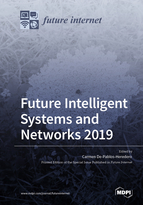Future Intelligent Systems and Networks 2019
A special issue of Future Internet (ISSN 1999-5903).
Deadline for manuscript submissions: closed (20 February 2019) | Viewed by 31535
Special Issue Editor
Interests: data management; open data; open innovation; health sector; agricultural systems; management models; relational coordination
Special Issues, Collections and Topics in MDPI journals
Special Issue Information
Dear Colleagues,
The evolution of Internet Systems in the Experience Society has made possible the co-creation of value that can be measured in terms of economic, organizational and social impacts. Firms and Public Institutions have put into action new business models according to new technology options and changed management efforts. Smart cities, smart farms, smart hospitals, smart production and smart education turn into higher levels of quality of life and promote the social and economic sustainability of our society.
Due to the increasing interests of governments, institutions and firms in evolving business models to “smarter environments”, this Special Issue intends to collect the current developments and future directions of “Future Intelligent Systems and Networks”. Hence, we encourage authors to submit original papers related to these fields.
Potential topics include, but are not limited to:
- Smart cities
- Smart governments
- Smarts Institutions
- Data reuse of information
- Innovative organizational models
- The Internet of Things
- Open innovation practices
- Business intelligence
- Social implications of collaborative networks
- Mobile computing innovative models
- Co-creation of value with Intelligent Systems and Networks
- Environmental and social sustainable applications
Prof. Dr. Carmen de Pablos Heredero
Guest Editor
Manuscript Submission Information
Manuscripts should be submitted online at www.mdpi.com by registering and logging in to this website. Once you are registered, click here to go to the submission form. Manuscripts can be submitted until the deadline. All submissions that pass pre-check are peer-reviewed. Accepted papers will be published continuously in the journal (as soon as accepted) and will be listed together on the special issue website. Research articles, review articles as well as short communications are invited. For planned papers, a title and short abstract (about 100 words) can be sent to the Editorial Office for announcement on this website.
Submitted manuscripts should not have been published previously, nor be under consideration for publication elsewhere (except conference proceedings papers). All manuscripts are thoroughly refereed through a single-blind peer-review process. A guide for authors and other relevant information for submission of manuscripts is available on the Instructions for Authors page. Future Internet is an international peer-reviewed open access monthly journal published by MDPI.
Please visit the Instructions for Authors page before submitting a manuscript. The Article Processing Charge (APC) for publication in this open access journal is 1600 CHF (Swiss Francs). Submitted papers should be well formatted and use good English. Authors may use MDPI's English editing service prior to publication or during author revisions.
Keywords
- Business intelligence
- Blockchain technologies
- Internet of things
- Reuse of data
- Smart cities
- Smart industries
- Open collaborative models
- Value co-creation
- Open innovation
- Social interaction
- Environmental sustainability
- Experience economy
- Intelligent systems and networks






